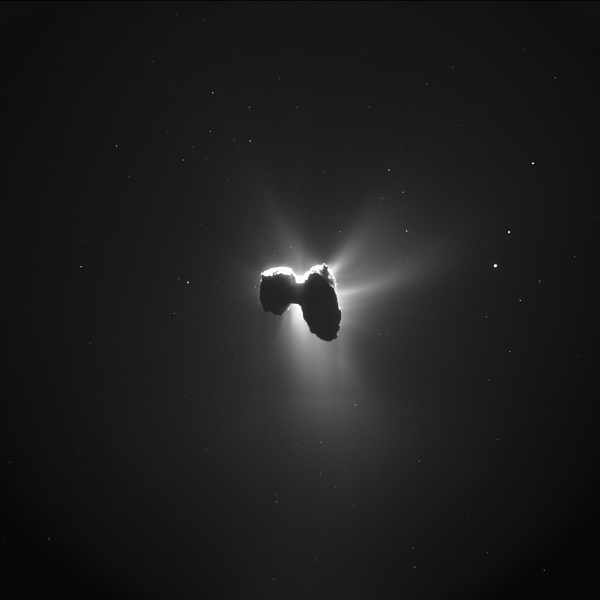By Ana Verayo, | April 02, 2016

Enhanced NAVCAM image of Comet 67P/C-G taken on 27 March 2016, 329 km from the comet nucleus.
This week, mission scientists from the European Space Agency revealed comet 67P in a stunning image, captured by the Rosetta spacecraft, backlit by our sun.
Like Us on Facebook
The Rosetta team announced that the probe is now orbiting some few hundred kilometers from the Comet 67P/Churyumov-Gerasimenko's tail, spewing vapor and dust from this frozen, dirty space rock. Possessing an odd "duck" shape, the comet is now travelling out of the inner solar system, as astronomers consider the comet as a classically active one. Comet 67P also visits our vicinity every 6.5 years.
To date, the Rosetta spacecraft is continuing its mission to study the composition and terrain of the comet where the probe is set to make a direct landing in September. Mission controllers will make sure that this touchdown will become easy for the probe for all data to return to Earth, as this marks the end of its mission.
As Rosetta will make this final, death dive to the icy comet, it is also most likely to be damaged upon impact and will end all contact from Earth. However, before this happens, scientists are working to obtain much data and information including imagery from the first spacecraft in the world that successfully orbits a comet.
The latest data and observations reveal how the tail of the comet works, that is now being blown away by solar winds. Using Rosetta's onboard navigation camera system, this latest image reveals comet activity along with this spectacular view from the sun as the comet and the probe are now over 400 million kilometers from the sun, travelling at 20 kilometers every second.
Rosetta was launched in 2004 where it has now completed more than 7.7 billion kilometers, reaching the neighborhood of Mars and even two asteroids before its final rendezvous of comet 67P back in August 2014. Shortly after, Rosetta deployed its lander Philae on the surface of the comet in November that year. Unfortunately, the lander suffered from a bumpy landing and is considered missing until now, draining its batteries and finally going into an eternal hibernation mode.
Comet 67P's closest approach to the sun was last August 13 where it was located inside the orbit of Mars. Now, the comet and probe are now moving out of the inner solar system, nearing the orbit of Jupiter. This means that since it gets farther away, the amount of solar energy it collects from its solar panels will now become more limited than ever before.
ESA scientists does not plan to place the probe into hibernation mode and then reviving it back when the comet enters the inner solar system again. When Rosetta completes its mission, the probe will send its last, close up images before it lands on its final resting place at the surface of comet 67P.
-
Use of Coronavirus Pandemic Drones Raises Privacy Concerns: Drones Spread Fear, Local Officials Say

-
Coronavirus Hampers The Delivery Of Lockheed Martin F-35 Stealth Fighters For 2020

-
Instagram Speeds Up Plans to Add Account Memorialization Feature Due to COVID-19 Deaths

-
NASA: Perseverance Plans to Bring 'Mars Rock' to Earth in 2031

-
600 Dead And 3,000 In The Hospital as Iranians Believed Drinking High-Concentrations of Alcohol Can Cure The Coronavirus

-
600 Dead And 3,000 In The Hospital as Iranians Believed Drinking High-Concentrations of Alcohol Can Cure The Coronavirus

-
COVID-19: Doctors, Nurses Use Virtual Reality to Learn New Skills in Treating Coronavirus Patients







